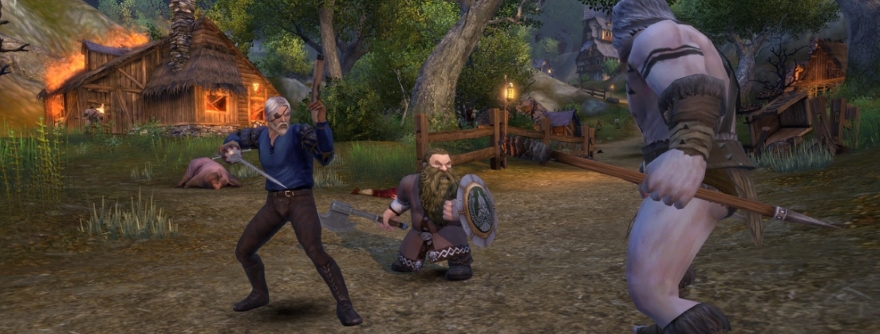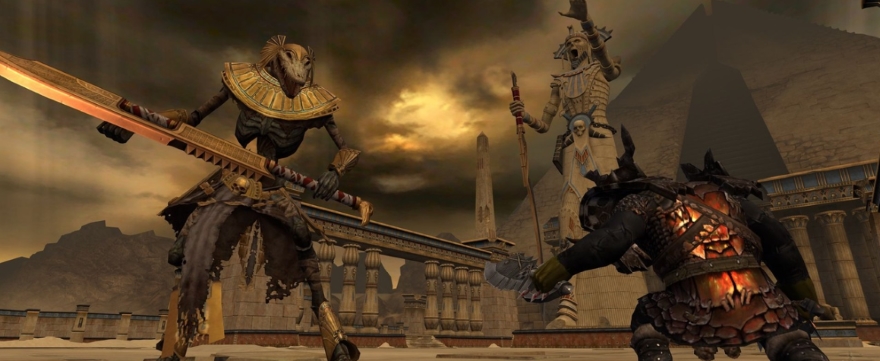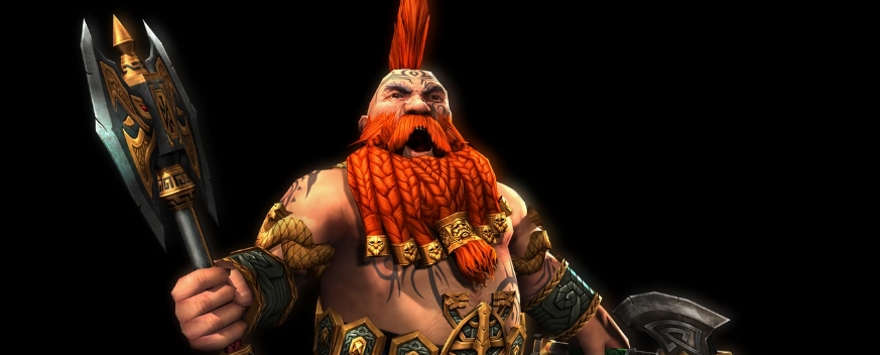
When it comes to notable years in the MMORPG genre’s history, 2008 stands out as one of the most significant. World of Warcraft’s debut onto the scene in 2004 caused an upheaval in ways far too numerous to go into detail here. Suffice to say that its overwhelming popularity drew the attention of game designers who looked at the staggering numbers of players and found themselves envious of the potential to grab a slice of that money pie.
Many projects went into high gear following WoW’s launch, with plenty of them trying to copy the formula and structure that Blizzard established in the hopes of making it at least partially as big as that game. So-called WoW clones began to pepper the market and there was a sense that gamers were ready to move on from World of Warcraft to the next generation of MMOs. In many players’ minds, this would be either 2008’s Age of Conan or Warhammer Online, two big-budget MMOs with strong IPs that carried a lot of the weight of expectation.
Little did anyone realize that 2008 represented a bubble that was about to burst on the industry and the WoW clones that followed — including Warhammer Online. Today, we’re going to take a look at “bears, bears, bears,” the high hopes of Mythic Entertainment, and how WAR became a casaulty on its own battlefield.

Pre-battle preparations
To do this story justice, we really need to start from two different points. The first is with Mythic Entertainment, a studio that emerged from online game companies of the 1980s. Mark Jacobs, a game designer who had been involved in this growing industry for over a decade, founded Mythic with Rob Denton in 1995. The fledgling studio focused on creating early online titles, leading up to the formation of Mythic’s breakout hit, 2001’s Dark Age of Camelot.
This “realm vs. realm” MMO put Mythic on the map as a serious player in the industry and generated a lot of player goodwill toward the studio as they spent years waging battles back and forth over continents. This focus on RvR was a specialty of the studio and a way for Mythic to distinguish itself from its competitors. It would certainly be a major factor in the studio’s future direction, as Mythic attempted and then gave up on a faction-based sci-fi title called Imperator Online.
It’s here that we need to jump to our other starting point to look at another studio and a different project entirely. Climax Online, a studio founded back in 1988, secured the rights to develop an online title set in Games Workshop’s very popular Warhammer fantasy universe. By 2002, this grim, gritty MMO was under construction and generating a lot of interest among fans.
Obviously, Climax’s Warhammer Online never came to be. Its downfall happened in 2004, when the price tag for the game’s completion was deemed far too high, with a total estimated budget of $30 million. Climax tried to shop around for another publisher with deep pockets, but to no avail. The studio gave up and the rights for Warhammer Online went on the table.
This was fortuitous timing for Mythic Entertainment, which saw the IP as ideal for a RvR-style MMORPG. Mythic secured the license in May 2005 and began work on its own version of the game which ended up being radically different from the vision that Climax had established.

Forming up the ranks
While Mythic had originally hoped to bring Warhammer Online to the public in 2007, the truth was that there was a lot more work to be done to get it ready for prime time. The press got its first look at WAR at E3 2006, and initial impressions were generally favorable. An Xbox 360 version was even rumored to be in production.
For fans of Mythic and WAR, a seismic change happened in June 2006 when EA announced that it had purchased Mythic Entertainment (which started the first of many name changes to the studio). “[This deal] is an opportunity to fulfill my dreams in a way that, frankly, wasn’t possible as an independent,” said Mark Jacobs at the time.
It has to be said that Mythic ran a masterful pre-launch campaign during 2007 and 2008. Hype and expectations were kept high as the devs released regular videos and posts that attempted to sell the vision of the game. In these, players were introduced to the Tome of Knowledge, retroactive kill quests (sparking Paul Barnett’s famous “bears, bears, bears” quote), the cosmetic trophy system, and how WAR’s RvR campaign was designed to function.
Meanwhile, delays in the MMO’s development kept occurring. Mythic pushed back the launch window from 2007 to Q1 2008. This news didn’t stop players from signing up to the beta test, which saw 200,000 hopefuls submit their registrations. By November 2007, Mythic announced another delay, this time to mid-2008. A final delay in early 2008 nudged the MMO to that fall. Even then, features such as several classes and four of the six planned capital cities, were cut from pre-launch development to avoid any more delays.
Eventually a launch date was set in stone, and on September 18th, 2008, Warhammer Online released to the world. Analysts anticipated that it would sell somewhere in the vicinity of 650,000 copies.

Charging into launch
When Warhammer Online left beta and officially launched in fall 2008, it was a massive event in the MMO world. Over a half-million players bought and registered the game in the first week, with many hoping that this would be the next evolution of MMOs. Reviews and responses were favorable, with the Metacritic score settling at 86%. By October 2008, over 750,000 players were logged into the game.
Even with Wrath of the Lich King arriving later that fall, Mythic was banking on players’ weariness of older MMORPGs and their eagerness to experience a new type of online game. “WoW, EverQuest, Camelot, by three years out they were really all — they really are in WoW’s case — losing a lot of users,” said Jacobs in a post-launch interview. “So if you’re looking at the perfect time to come out for a new MMO, it would certainly be when the competition is three or four years out.”
To many players, Warhammer Online looked and functioned like a more advanced and gritty version of World of Warcraft. While it contained many of the features that MMO players had grown accustomed to seeing, the worldwide PvP focus, the public quests, the achievement system, and the overall aesthetic set it apart from a mere WoW clone.
At its heart, however, WAR was a PvP game at its core. Mythic decided that many players who were frightened off by PvP might be trained to come over from PvE if done just right. This is why WAR’s maps were lopsided in favor of PvE in early zones while introducing limited PvP mechanics, then progressed to a heavier PvP focus until realm-vs.-realm conflict took up most of the Tier 4 maps and capital cities. Speaking of which, it was a major proposed feature of the game that players could put enemy capitals under siege (which worked in a fashion).
Some of the cut classes were reintroduced post-launch. Players got to try out the Dark Elf Black Guard, the Empire Knight of the Blazing Sun, the Chaos Chosen, the Greenskin Choppa, the Dwarven Ironbreaker, and the Dwarven Slayer in the months to follow.
Mythic also forged ahead with a major update (which bordered on an expansion) in spring of 2009. Land of the Dead introduced a zone that looked like a horror-themed Egypt. The studio billed it as a spiritual successor to its Darkness Falls content in DAoC (as well as the Darkness Falls MUD that it ran back in the ’90s).
In 2009, Mythic announced that it was bringing Warhammer Online to Macs. According to the press release, “WAR for the Mac was made possible using the Cider Portability Engine from TransGaming that acted as a ‘wrapper’ around the game software, enabling it to run seamlessly on Intel-based Macs. TransGaming’s Cider technology allowed Mythic Entertainment to rapidly enable and deploy WAR for the Mac.”

An inglorious death
Although it had an incredibly strong start, Warhammer Online didn’t prove to have the staying power that Mythic anticipated. Staff cuts happened in February 2009, with a loss of many QA and customer support personnel. The population started to slip, and by March 2009, Mythic reduced the number of servers from 126 down to 63, with around 300,000 players still romping around in this virtual playground.
Executive Producer Jeff Hickman gave a talk at GDC a year after WAR’s launch in which he idetified three major mistakes that Mythic made with the title. These were, in his view, overly easy PvE in the early game, a lack of socialization, and a weak in-game economy.
Less than a year after WAR’s launch, Mark Jacobs was let go from Mythic by EA. Mythic was then folded into EA BioWare’s RPG division and overseen by Ray Muzyka and Greg Zeschuk. It wasn’t a good sign. In July 2010, Mythic and BioWare merged completely to become BioWare Mythic while WAR limped on with a vastly reduced development team.
Seeing the warning signs and taking a cue from the newly popular MOBA genre, Mythic’s devs fashioned a MOBA of their own out of Warhammer Online’s assets. Wrath of Heroes used many of the same classes and maps but in a MOBA format. It was an ambitious plan — but ultimately went nowhere, as the title never made it out of beta.
While it enjoyed a huge first half-year, the remainder of Warhammer Online’s four-and-a-half-years was plagued with doubt and falling subscription numbers. While a move to a free-to-play model could have done wonders to prop up the RvR MMO, no such business model shift ever occurred.
Five years after its launch, EA announced that Warhammer Online would be closing its doors on December 18th, 2013. “Both Games Workshop and Mythic agreed to part ways, despite how hard it is emotionally on us to let the game go,” said Producer Carrie Gouskos.
The studio itself didn’t outlast WAR for very long. After a couple of attempts to keep the Mythic alive with mobile titles, EA announced that it was shuttering the studio in May 2014. At least there was a silver lining to this cloud, with Dark Age of Camelot and Ultima Online continuing to thrive under the guidance of Broadsword Studios and Mark Jacobs bringing a new vision of RvR MMO to fruition with Camelot Unchained.
Related reading:
 Believe it or not, MMOs did exist prior to World of Warcraft! Every two weeks, The Game Archaeologist looks back at classic online games and their history to learn a thing or two about where the industry came from… and where it might be heading.
Believe it or not, MMOs did exist prior to World of Warcraft! Every two weeks, The Game Archaeologist looks back at classic online games and their history to learn a thing or two about where the industry came from… and where it might be heading.













